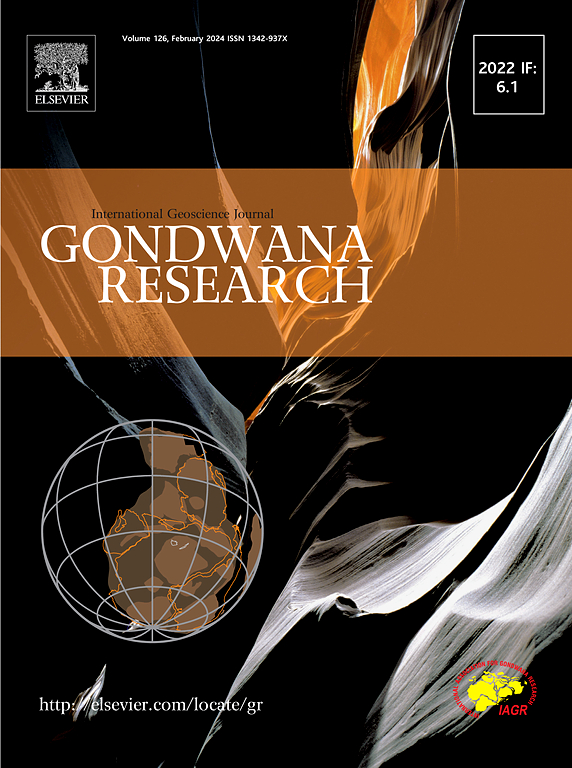Zircon petrochronology of volcano-sedimentary sequences unraveling the timing of epithermal gold mineralization at the Axi deposit, Tianshan, NW China
IF 7.2
1区 地球科学
Q1 GEOSCIENCES, MULTIDISCIPLINARY
引用次数: 0
Abstract
Epithermal gold deposits are prime exploration objectives in subaerial volcano-sedimentary basins. However, the ages of epithermal gold deposits in ancient orogenic belts have long been difficult to obtain, largely due to the general lack of minerals unequivocally linked to gold deposition that can be accurately dated by radiogenic isotope techniques. The well-preserved Devono-Carboniferous volcano-sedimentary sequences and angular unconformity directly overlap the orebodies of the Axi epithermal gold deposit in Chinese Tianshan and provide a rare opportunity to unravel the timing of gold mineralization and post-mineralization processes through combined U–Pb zircon dates with zircon geochemistry investigations from volcanic host rocks, basal breccias and its sedimentary cover. Two weakly-mineralized host andesite samples yielded zircon U–Pb ages of 361.2 ± 1.8 Ma and 349.7 ± 2.6 Ma, respectively. The basal breccia of the sedimentary cover immediately above the angular unconformity contains a mineralized andesite clast (348.2 ± 2.0 Ma) derived from the erosion of the underlying epithermal deposit. Combined with a maximum depositional age (MDA) of ca. 344.0 ± 3.8 Ma for the clastic rocks directly overlain the basal breccia, suggesting that the Axi angular unconformity was formed in the early Visean (ca. 348.2–344.0 Ma). The youngest detrital zircons from clastic rocks in the upper section of the sedimentary cover constrain its deposition to ca. 344.0–305.3 Ma. These data together indicate that epithermal gold mineralization at Axi predates formation of the angular unconformity at no later than ca. 344.0 Ma. Rapid burial of the gold mineralization by the sedimentary cover (i.e., Aqialehe Fm; ca. 344.0–305.3 Ma) soon after exhumation (ca. 348.2–344.0 Ma) was crucial for the preservation of Early Carboniferous epithermal gold mineralization at Axi.

火山-沉积序列的锆石年代学揭示了天山阿西矿床浅成热液型金矿成矿的时间
浅成热液型金矿是陆下火山-沉积盆地的主要找矿目标。然而,古造山带浅成热液金矿床的年龄长期以来一直难以获得,这主要是由于普遍缺乏与金沉积明确相关的矿物,而这些矿物可以通过放射性成因同位素技术精确地确定年代。保存完好的泥盆-石炭系火山-沉积层序和角不整合直接覆盖了中国天山阿西浅成热液金矿床的矿体,通过结合火山寄主岩、基底角砾岩及其沉积盖层的锆石地球化学研究,为揭示金矿成矿时间和成矿后过程提供了难得的机会。2个弱矿化安山岩样品的锆石U-Pb年龄分别为361.2±1.8 Ma和349.7±2.6 Ma。角不整合上方的沉积盖层的基底角砾岩含有矿化的安山岩碎屑(348.2±2.0 Ma),源自下伏浅成热液矿床的侵蚀作用。结合直接覆盖于基底角砾岩上的碎屑岩的最大沉积年龄(MDA)约为344.0±3.8 Ma,表明阿西角不整合形成于早西世(约348.2-344.0 Ma)。盖层上部碎屑岩中最年轻的碎屑锆石约束其沉积约为344.0 ~ 305.3 Ma。这些资料表明,阿西浅成热液型金矿成矿早于角不整合形成,时间不晚于约344.0 Ma。沉积盖层(即阿恰勒河组)对金矿的快速埋藏作用;ca. 348.2-344.0 Ma)是保存阿西早石炭世浅成热液金矿化的关键。
本文章由计算机程序翻译,如有差异,请以英文原文为准。
求助全文
约1分钟内获得全文
求助全文
来源期刊

Gondwana Research
地学-地球科学综合
CiteScore
12.90
自引率
6.60%
发文量
298
审稿时长
65 days
期刊介绍:
Gondwana Research (GR) is an International Journal aimed to promote high quality research publications on all topics related to solid Earth, particularly with reference to the origin and evolution of continents, continental assemblies and their resources. GR is an "all earth science" journal with no restrictions on geological time, terrane or theme and covers a wide spectrum of topics in geosciences such as geology, geomorphology, palaeontology, structure, petrology, geochemistry, stable isotopes, geochronology, economic geology, exploration geology, engineering geology, geophysics, and environmental geology among other themes, and provides an appropriate forum to integrate studies from different disciplines and different terrains. In addition to regular articles and thematic issues, the journal invites high profile state-of-the-art reviews on thrust area topics for its column, ''GR FOCUS''. Focus articles include short biographies and photographs of the authors. Short articles (within ten printed pages) for rapid publication reporting important discoveries or innovative models of global interest will be considered under the category ''GR LETTERS''.
 求助内容:
求助内容: 应助结果提醒方式:
应助结果提醒方式:


